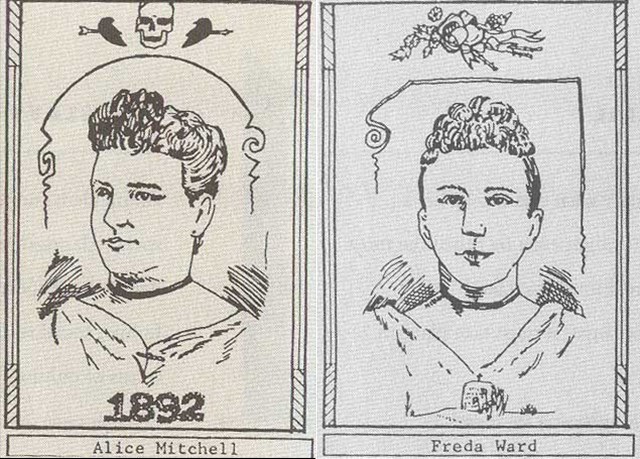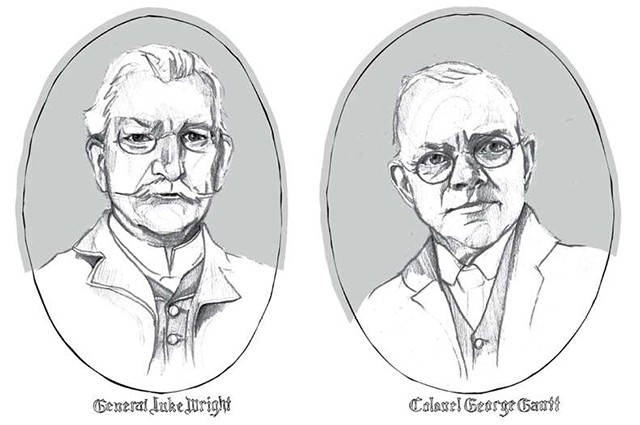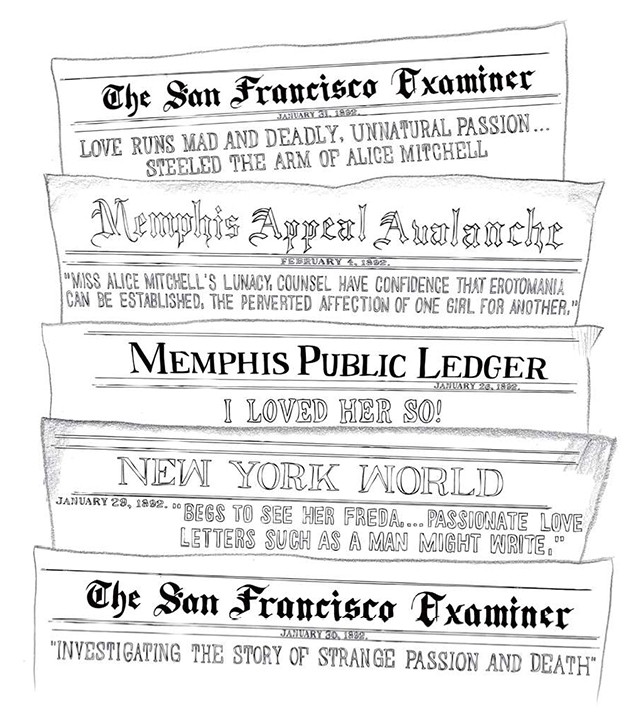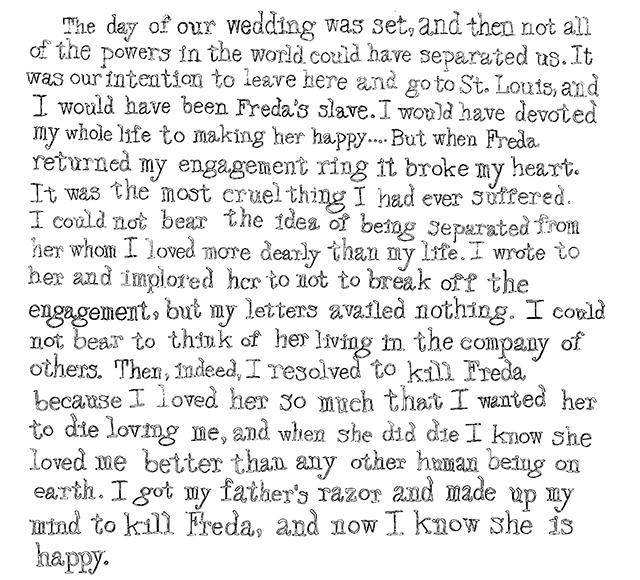Erotomania and Murder in Memphis


Alice+Freda Forever: A Murder in Memphis by Alexis Coe, is out now. You can order it from wherever you choose to prepare for the coming apocalypse:
• Powell’s
• Amazon
Less than an hour after the murder, Memphis’s Chief of Police knocked on the front door of the Mitchell’s fashionable home on Union Street. Chief Davis was sorry to disturb “Uncle George,” as the retired salesman was affectionately called, and sorrier still for the decidedly unpleasant nature of the call. He had come to arrest George Mitchell’s youngest daughter for the murder of Freda Ward.
George had been expecting him. He readied himself and Alice for a trip to the jailhouse, just a few minute’s walk from the scene of the crime. He waited patiently as Davis booked his nineteen-year-old daughter on the charge of murder, amiably chatting with jailers, all sympathetic friends who promised to look after Alice while he sought legal representation.
By eight o’clock that evening, George returned with two of the most prominent, expensive attorneys in Eastern Tennessee, if not the entire state. Both Colonel George Gantt and General Luke Wright were affluent, respectable Memphians from old, Southern families. They had emerged as community leaders after a series of yellow fever outbreaks in the 1870s all but ruined the city; Memphis’s charter was revoked, the economy stalled, and its population dwindled, with thousands buried and many more having fled, never to return.
Col. Gantt was considered Memphis’s preeminent litigator, peerless in legal research and unrivaled in courtroom debate. The firm that bore his name was a breeding ground for high level political and business leaders, whose power and wealth gave them an extraordinary degree of influence in the South.
Gen. Wright, son of a Tennessee Supreme Court Justice, had a distinct advantage in the case. His title was honorific, bestowed upon him for a commendable job as attorney general in Shelby County, where the Mitchell-Ward case would be heard. He would go on to collect far more titles in his career, serving as the first United States Ambassador to Japan, and then as Secretary of War under President Theodore Roosevelt.

Despite the defense’s legal prowess, it was George Mitchell, and not the lawyers he hired, who determined Alice’s plea. It was not the first time he had peremptorily imposed a diagnosis in his family. George had placed his wife, Isabella in the hospital after she gave birth at home — three times — deeming what was likely postpartum depression as behavior unsuitable for a wife and mother.
On the very night Alice had slashed a seventeen-year-old woman’s throat, her father convinced two formidable lawyers that his daughter could not be tried for murder. There was no denying that she had killed Freda — Alice had already confessed, and there were plenty of witnesses — but in 1892, her motive was utterly inconceivable to them. Alice’s insistence that she killed Freda because she loved her and could not stand the idea of anyone else having her, and that the young women had planned to marry, seemed nothing short of insane.

By the time Gantt and Wright emerged from Alice’s cell that evening, they had an interview in hand and a plan of action.
No one outside of the judicial system would be allowed to speak to Alice, and those within it would be closely supervised. By denying access to their client, Gantt and Wright could carefully manage Alice’s story, since any reports disseminated through the press could possibly set the tone for the entire trial.
Their first opportunity to steer the public narrative presented itself the moment Alice’s newly formed defense team exited the jailhouse. News of a well-to-do white woman turned murderess were rapidly circulating through Memphis. Gawkers and journalists alike had already begun swarming outside of the building, desperate for any information about what was rumored to have been — to use what would become one of their favorite words for the case — an unnatural crime. They were desperate to hear Alice’s side of the story, and happy to accept the version Gantt and Wright were peddling. And the defense was more than happy to see the press and spectators repeat what they had heard as if it were firsthand account, as if they had heard the words spoken by Alice herself.
But Gantt and Wright had no intention of giving them the whole statement that night. Borrowing from a publishing format usually reserved for works of fiction, they serialized Alice’s interview, releasing it in bits and pieces over the next few days, keeping reporters and readers tantalized and hungry for more. The defense made good use of the time in-between the daily publication, seeking out a team of medical experts to add weight to the plea they hoped to file — present insanity — and all in time to be printed in the next installment.
Gantt and Wright were no strangers to mass media. They understood the public’s bottomless desire for sensational news stories, especially for crimes of passion. They correctly anticipated that the Mitchell case, a cornucopia of scandalous detail, would attract unprecedented attention. The inescapable din of news reports, gossip, and fervent speculation would surely reach the ears of potential jurors.
Steering the press’s narrative was also the quickest way to get to Judge Julius DuBose, who presided over all the cases in the jailhouse. It was easy enough to predict he would turn to the Memphis Public Ledger first. Not only had he started his career as an editor at the Public Ledger, but the paper had the clear advantage over all the other outlets: It was the first, longest running, and most popular evening paper in Memphis. If any newspapers were going to influence the judge, it would be the Public Ledger. The reports and editorials in the paper not only had the potential to spin their own version of the latest details in the case, but more importantly, serve as a daily performance review of the judge himself. It was possible that, after reading the nightly paper, Judge DuBose would take its opinions into consideration as much as the evidence presented in court.
In 1892, there were more than a dozen papers in Memphis, all of which were owned by local white men who wielded power in various realms. This was business as usual in the press; even Wright, just a few years earlier, had gladly stepped up as one of the first investors in the Memphis Commercial. Powerful Memphians backed their pet publications in order to further their business, personal, and political agendas. These competing factions modeled themselves after New York’s lucrative, mass circulation papers, where advertisers paid top dollar to appear next to a sensational story, in turn sending the newspapers’ circulations soaring.
This was certainly the practice of the Public Ledger and the Commercial. But to be truly successful in shaping opinions statewide — and as it would turn out, around the nation — Gantt and Wright would have to win over the Memphis Appeal Avalanche.
The Appeal Avalanche was the largest morning paper in the city, and made bold claims on the entire state of Tennessee. Though just a couple of years old, it possessed two things no other paper in Memphis had: a linotype machine and an exclusive deal with the Associated Press. The linotype produced an entire line of metal type at once, a far more efficient and faster means of publishing than the old industry standard, the manual process of setting type letter-by-letter. The Associated Press was around forty years old by the time the Appeal Avalanche joined, and the news cooperative had enjoyed a legendary reputation for dramatically increasing the transmission of news across the country since the Civil War.
Just before midnight, local papers sent what little information they had about the murder of Freda Ward through the wire, and by morning, big urban dailies in major cities were already desperate for more. Nothing in Memphis had ever attracted such national interest, and thus none of the national, mass circulation papers had reporters stationed in the vicinity. As they scrambled to tap local journalists, the largest, most far-flung American newspapers, including the New York World and the San Francisco Chronicle, ordered their staff writers to board the next train to Tennessee.

In the days that followed the murder, nearly every newspaper in the country eagerly printed fact alongside fiction, eschewing even the most basic research efforts in favor of speedy transmission. The out-of-towners were exempt from local redress, and those newspapers took liberties with even the smallest details. The North American of Philadelphia aged seventeen-year-old Freda to nineteen, and reported that the young women’s estrangement began because “Freda’s friends considered Miss Mitchell ‘too fast.’”
The New York Times misspelled Lillie Johnson’s first and last name, identifying her as “Lizzie Johnston,” and offered a muddled timeline in which Alice first murdered Freda, and then cut Jo.18 Memphis readers would have immediately questioned the article’s sub-headline, in which the paper of record erroneously identified Alice as a “society girl.” In the social hierarchy of the South, slave-owning families who had made millions in cotton and horse breeding were “familiar figures in society,” not a merchant’s daughter. Similarly, Freda, the daughter of a machinist who had sought greater prospects up river in Golddust — and came from a family that was far less well-to-do than the Mitchells — was not a member of Tennessee’s semi-aristocratic class. Neither girl had made the guest lists at parties the Memphis elite staged on their sprawling estates, many of which still operated as plantations.
But local newspapers specialized in their own brand of creative reporting, including embellishments that read more like popular fiction than true crime. Judge DuBose’s former employer, the Public Ledger, described the murder scene with flourish:
“Grasping her by the hair Miss Mitchell pulled her head back, exposing the round, white throat. Again the keen razor was brought into play, and this time it did its work with frightful completeness. The girl was almost beheaded, and fell fainting to the ground, which was soon drenched with her rushing blood.”
The racial identifiers — the New York Times emphasized Freda’s “white bosom” and the Public Ledger spoke of her “white throat” — were visceral scare tactics used to remind readers that these were the kind of people they knew and cared about. Journalists knew that the story would be far less consequential to readers if the murderer and victim had been male, not white, or of lesser economic means. And if they could punctuate the scene with a subtly sexualized near-beheading, all the better.
To American readers in the 1890s, the most confusing part of the Mitchell case had little to do with inconsistent reporting. The early headlines emphasized how confounding the very idea of same-sex love was in the first place. Reporters relied heavily on words like “unnatural,” “strange,” and “perverted.”

When all else failed, reporters attempted to explain that Alice was “a man” in the relationship. Though, they conceded, not masculine in her dress or countenance, her supposedly hidden proclivity toward all things male was yet another way reporters could contrast Alice with “normal” young women. In an interview with the Appeal Avalanche, Gantt explained that Alice had quietly, but consistently, defied gender norms her entire life:
“…everything she has done, her peculiarities, whether during her infancy she played with dolls or other such toys in which the average female delights, whether she had a fondness for those of her own or the opposite sex, all of these will be circumstances going to show the state and quality of her mind.”
Newspapers enthusiastically accepted whatever scraps of information the defense tossed at them, and relied on an abundance of loose-lipped locals to fill in the gaps. The city was overtaken with intrigue, and there were hordes of Memphians who wished to weigh in on the murder. Some sought to correct erroneous material, but more often than not, they offered subjective observations. These opinions were often based on personal experience
with the Mitchells or the Wards, though as time went on, they were clearly influenced by what they read in the newspapers, too. Others, whose lack of connection to the case did not deter them from offering highly quotable views and speculation, were also tapped as ongoing sources. These unreliable perspectives were no more subject to fact checking than any of the other details making their way across the nation.
Neighbor John Perry offered what was likely a nebulous recollection of the Mitchell’s youngest daughter, combined with what he had obviously absorbed about the version of Alice now being discussed in newspapers as an insane murderess.
“I live next door to Mr. George Mitchell and have known Alice for nine years or more, and have never considered her strong mentally. Her manner has been always flighty and unsettled and her ways different from that of most girls. She was of an impulsive disposition, and given to doing very much as the present mood inclined her, whether it was to snatch up a rifle and stand about her yard shooting sparrows or to ride a bare back horse at break-neck speed about the premises. I have never seen anything about her conduct that was at all immodest, nor was she the least bit fast as regards to men. On the contrary, she seemed to care nothing for them and rather preferred the society of her own sex. . . . From a long and close knowledge of Alice Mitchell her act was that of an insane woman.”
Concerned citizens, and those with other sorts of motives, reached out to the authorities as well. The attorney general’s office received many letters, both signed and anonymous, riddled with suspect details, outlandish claims, and transparent lies. While the offices of the court and the police privately dismissed the more outrageous reports, they were more than willing to turn around and discuss them with reporters. Attorney General George Peters was constantly asked about a popular rumor that Alice Mitchell had sent the office a letter from jail, but Peters shunned it as “the ebullition of a crank.” Likewise, a Memphis detective relayed a phone call he received from an agitated man in Cincinnati who informed him that three years prior to Freda’s murder, Alice had “made love like a man to his daughter, now deceased.”
Relentless messages concerning the supposed unnaturalness of Alice’s motives were clearly working. In the mind of the public, she seemed endowed with an almost supernatural power to commit heinous acts, no matter the time or place.

The prosecution offered very little information beyond stating that Alice was of sound mind — a decidedly insipid claim next to the defense’s adamant plea; dramatic presentation of sensational, anecdotal “evidence”; and aggressive campaigning. Public opinion was leaning toward the defense, but Gantt and Wright had yet to play their wild card: the most incendiary part of Alice’s statement.
The Appeal Avalanche published this part of Alice’s statement under the headline, “WHO IS THIS JESSIE JAMES?”

Today’s readers are likely to interpret this confession as the unfortunate saga of a troubled, teenage romance turned deadly: Alice believed she had found her one true love, and that their commitment could withstand any challenge — or be immortalized by death. For some time, Freda felt the same way, or at least proved convincing enough that the withdrawal of her affections truly broke Alice’s heart. Her only solace was the assumption that Freda was bowing to familial pressure, and when she learned this was not the case, that Freda’s love had been fickle, Alice was determined to hold her to their agreement. If any part of her statement casts a doubt on Alice’s sanity, it is the conclusion, in which she claims to know Freda is happy to have been murdered.
But to Americans in 1892, her insistence on loving and wishing to marry and support a woman were, in and of themselves, clear signs of lunacy, and there was no shortage of physicians willing to corroborate that assumption. Still, in their efforts to create an airtight case, Gantt and Wright scoured Eastern Tennessee in search of the most prominent and influential physicians for supporting testimony. The prosecution had far less luck finding doctors to refute the plea, while the newspapers, sensing readers wanted some medical context, readily printed any theory that called itself scientific.
The first “prominent physician” quoted in a newspaper — or at least, the first one who made it to press — diagnosed Alice with erotomania, defining it, inaccurately, as “unnatural affection between two persons of the same sex.” Other doctors, also unnamed, would assert erotomania was a “malady of the mind” that could easily “lead on to murder.”
Whether or not the unnamed doctors’ quotes were fabricated by overzealous newsmen, their alleged interpretations of erotomania were as legally convenient as they were medically creative. For more than two centuries before Alice murdered Freda, erotomania had described “forms of insanity where there was an intensely morbid desire to a person of the opposite sex, without sexual passion.”
While the Mitchell case would eventually produce new meanings, Gantt and Wright would not rely on the diagnosis of erotomania. In fact, the lawyers would avoid any argument that contained even a hint of the erotic, and most certainly any that acknowledged actual sex acts. Sex between two women was not entertained, even as a theoretical proposition. The defense and prosecution, as well as most newspapers, tacitly agreed on this point: There would be no public discussion of anything even faintly sexual. Three years later, the English press would similarly cover the libel case Oscar Wilde lodged against the Marques of Queensberry, who left the writer a calling card inscribed, “For Oscar Wilde, posing somdomite [sic].” Wilde’s sexual preference was never explicitly identified, but simply suggested through vague euphemisms, which included the very words the press seized upon and frequently applied to Alice — “unnatural,” “immoral,” and “indecent.”
That should not suggest the papers were unwilling to test the waters, even granting that Alice and Freda had experienced some “gratification of the perverted mental passion.” The defense, however, was always quick to push back against these claims, insisting Alice and Freda’s love was “purely . . . mental.”

Who was Alice Mitchell? Why did she kill Freda Ward? Was she a masculine murderess? A pervert? A fast and jealous young woman? Or was she insane, like her mother?
Just as the Mitchells insisted that the defense argue for Alice’s insanity, the Wards pushed the prosecution to maintain the opposite. “She was no more crazy than I am,” asserted Ada’s husband, William Volkmar, an “old Memphis boy” who had hosted Alice in his home.30 Alice said “I don’t care if I’m hung,” Jo Ward recalled, insisting the murder was premeditated, and carried out in cold blood. Neither quoted the writer Mark Twain, but they would have found agreement in his essay, “A New Crime — Legislation Needed.” Two years before Alice was born, Twain bemoaned the rise of the insanity plea, and how it allowed for otherwise unremarkable behavior to be recast as proof of an unsound mind.
“Of late years it does not seem possible for a man to so conduct himself, before killing another man, as not to be manifestly insane. If he talks about the stars, he is insane. If he appears nervous and uneasy an hour before the killing, he is insane. If he weeps over a great grief, his friends shake their heads, and fear that he is “not right.” If, an hour after the murder, he seems ill at ease, preoccupied and excited, he is unquestionably insane.”
But it was the prosecution’s case — and not the defense’s plea — that newspapers characterized as inconsistent and unconvincing. Attorney General Peters called Alice “fast,” citing jealousy over a man as a possible motive, but also claimed she was indifferent to men. At the very least, he argued that she was ill-tempered and vindictive, but certainly not insane.
By questioning Alice’s moral character, Peters challenged readers’ cherished notions of the Mitchell family’s respectability, and few outside the Ward family were interested in that perspective. The Appeal Avalanche soon reported that “the preponderance of public opinion is in favor of the theory that Alice Mitchell is insane.”
Months before the lunacy inquisition would officially commence, the defense could claim public opinion as its first victory. Mass media played an influential role in regulating the boundaries of American modernity, and such a high-profile domestic tale on public display provided a means to do so. The defense offered editors a message they wanted to propagate: Alice was a well-to-do white woman from a pious family who was neither bad nor fast, and did not deserve to be in jail among base miscreants of every race and class. The public most certainly refused to see her hanged, with her fine family looking on.
Of course, the papers could not uniformly align themselves with the defense. Debate was a useful strategy when it came to selling copies; it was in the newspapers’ interest to see that all positions were argued for vociferously. In Memphis, the Appeal Avalanche supported the case for insanity in lockstep with Gantt and Wright, while the Commercial often challenged them. If Alice had indeed loved Freda, the paper contended, she should be judged as a man would be, had he committed a crime of passion. She was legally responsible, they argued, “because she cowardly ran away. Had she been wholly irresponsible and insane, she might have acted differently after drawing the razor across Miss Ward’s throat.” The Appeal Avalanche countered that the ability to function in daily life was irrelevant, as was any talk of treating a woman like a man, maintaining that Alice was “the slave of a passion not normal and almost incomprehensible to well-balanced people.” On that point, the Commercial almost always retreated.
Before Alice even entered the courtroom, newspapers across the country had latched on to every detail, real or imagined, of what they considered a particularly lurid murder. But national fascination with the case was about far more than the death of a seventeen-year-old girl, or a desire for entertainment and spectacle. Same-sex love, passing as a man, and alternate domesticities challenged everything Americans understood, and were desperately holding on to, in the late nineteenth century. During the next six months, this domestic drama would put issues of morality, individual liberty, and mental health front and center, forcing people to have a stance.
But first, Lillie Johnson would have to be arrested, and Freda Ward laid to rest.
Alice+Freda Forever: A Murder in Memphis is Alexis Coe’s first book. In addition to being The Awl’s Hammer Time columnist, she has contributed to the Atlantic, the Paris Review Daily, Slate, the Toast, the Hairpin, and many other publications.
She’ll be discussing the book tonight at Housing Works at 7pm.
Top images via
